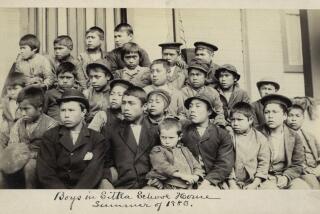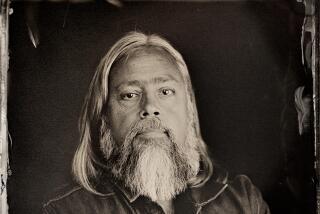Looking at Indian Wars with the present in mind
- Share via
A coffee-table book on the Indian Wars of 1854 to 1890?
Surely Michael Blake couldn’t have had that in mind when he wrote his first nonfiction work, “Indian Yell,” which is clearly intended to bring to a new generation the message of “Dances With Wolves.” (Blake wrote the novel, then the screenplay for the Kevin Costner movie.) Loaded terms such as “insurgency” in the subtitle and “shock and awe” in a chapter heading link the current war in Iraq with America’s earlier campaigns to impose its will by force and deceit on native peoples it didn’t bother to understand.
“The ‘greatest nation on Earth’ ... adopted the actions it took toward American Indians in the 19th century as a model of behavior toward people of different beliefs in the 20th century and beyond,” Blake declares. After the fighting was over -- and Blake doesn’t hesitate to use the word “genocide,” even when discussing the slaughter of the buffalo -- the United States treated Native Americans with “aggressive and premeditated neglect,” on the assumption that they would eventually “become extinct.” Yet a coffee-table book is what Blake has come up with, and not just because of its wide-page format, lavish use of period photographs and slender text. It’s history without footnotes, a well-meaning rant, a personal venting. The only bibliography is a suggestion at the end of each chapter that the reader consult one of the books Blake distilled into “Indian Yell.” Thus, his account of the U.S. war against the Brule Sioux over a cow allegedly stolen near Fort Laramie in present-day Wyoming -- the Grattan “massacre” of 1854 and William S. Harney’s punitive expedition the following year -- cites “The Long Death” by Ralph K. Andrist; the chapter on the Apache wars of the Southwest -- in which Blake’s great-grandfather participated -- refers to “Once They Moved Like the Wind” by David Roberts, and so on.
Mostly, we have to take what Blake says on faith, and he isn’t shy with his opinions. He calls Sioux chief Sitting Bull “one of the world’s greatest leaders.” James McLaughlin, the Indian agent who conspired to have Sitting Bull killed in South Dakota in 1890 -- triggering the final bloodshed at Wounded Knee -- was “one of the worst that ever existed” in the “long, sordid” line of such officials. Capt. Frederick Benteen, who delayed coming to the aid of Lt. Col. George Armstrong Custer at the Little Big Horn, had a “vile nature.” We might expect “Indian Yell” to give Custer yet another bashing, but readers of Blake’s 1996 novel “Marching to Valhalla” will know better. He is, in fact, a Custer partisan. Unlike other Civil War heroes such as Gens. William T. Sherman and Philip H. Sheridan, who single-mindedly advocated the same scorched-earth strategy that had defeated the Confederacy, Custer was interested in the culture of the Plains tribes and shared their warrior ethos, Blake says. He credits Custer with intervening to protect Cheyenne women and children at the Battle of the Washita in 1868 and says his sexual relationship with a Cheyenne captive, Monahsetah (after whom Blake named one of his daughters), was affectionate. Blake even attempts to refurbish Custer’s reputation as a tactician, saying he had no way of knowing how many enemies awaited the more than 200 men he led to their deaths in 1876.
To be fair, Blake’s Missouri River approach -- shallow but wide -- isn’t the worst introduction to the Indian Wars, which he calls “one of the most poignant, instructive, and, despite enormous tragedy, most romantic periods in the history of America.” The famous battles appear beside lesser-known but equally significant events. For example, one of the most brutally efficient campaigns the U.S. Army waged against the Plains tribes involved few human casualties. In 1874, Col. Ranald S. Mackenzie led his troops down into Palo Duro Canyon in the Texas Panhandle, the supposedly impregnable winter camp of the Kiowa and Comanche. As the surprised Indians scrambled up to the rim of the canyon, Mackenzie burned their lodges and rounded up more than 1,400 horses. He gave 300 to his men, then ordered the rest shot. “A free-roaming native without a pony was as impotent as a vehicle without wheels,” Blake notes, and had no choice but to return to the reservation, where, thanks to corrupt agents and suppliers, “there was no food ... no way to make any kind of living, and absolutely nothing to do.”
*
Michael Harris is the author of “The Chieu Hoi Saloon.”
More to Read
Sign up for our Book Club newsletter
Get the latest news, events and more from the Los Angeles Times Book Club, and help us get L.A. reading and talking.
You may occasionally receive promotional content from the Los Angeles Times.







